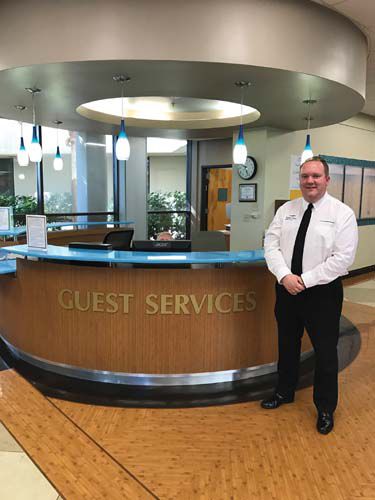
Starting next Monday, visitors to the Indian River Medical Center will be greeted with what the hospital hopes will be an upgrade in customer service as well as enhanced in-house security.
The Vero hospital’s new initiatives will include “service ambassadors” stationed in the main lobby as well as at the entrances to both the emergency department and the patient pavilion, and, for the first time since August 2013, a “visitor badging” program will be put into use.
Todd Schwanke, the newly designated Security and Service Ambassador Manager, says after supplying a photo ID – or posing for a quick webcam picture – visitors will be issued a high-tech paper badge while the ambassadors assist with directions and even maps showing the way to visitors’ desired destinations within the hospital, including patient rooms, the medical records department and doctors’ offices both in and outside the building.
The emphasis, according to Schwanke, “will be on customer service,” and he points out that his team of ambassadors is largely made up of familiar faces. “I would say 90 percent of my staff has been hired from within, so they already know the hospital,” and, presumably, many of the patients as well as visitors to the Vero Beach facility.
While it might seem somewhat counterintuitive to link customer service to security, there does appear to be a strong link between the two.
Security Magazine, a trade publication for both cyber and physical-plant security professionals, points out in its October 2016 issue that “between illnesses, family tension and medical bills, hospitals are already harbors for stress, and nothing escalates a stressful situation into a dangerous one faster and more unnecessarily than poor customer service.”
Moreover, the New York Times reported earlier this year that since 2012, “healthcare institutions have reported a 40 percent increase in violent crimes with more than 10,000 incidents nationwide.”
The International Association for Healthcare Security and Safety adds that gang activity, illicit drug dealing and domestic disputes involving hospital personnel do sometimes “spill in from the streets,” compounding the security problems faced by hospitals.
So, perhaps an ounce of prevention – in the form of enhanced customer service projects and visitor badging – will be worth more than a pound of cure.
The going rate for this particular ounce of prevention is roughly $300,000, which is what Schwanke estimates these new programs will cost the hospital annually.
Meanwhile, back to the badges. According to Schwanke, “The badges we’ll be handing out to visitors will be heat sensitive and time sensitive. After a period of 24 hours [the badge] will fade and will actually say ‘Stop.’ That will alert not only our employees but also our security” about how long the visitor has been in the hospital.
The “soft opening” for the new service ambassador and badging program is slated for Dec. 5, and by the next day Schwanke expects both to be fully operational. He adds that the hours at the main lobby entrance will boosted by two hours each day going from 7 a.m. to 7 p.m., to the new 7 a.m. to 9 p.m.



